Oaxaca, Mexico.
Travel & Tour
Pictures, Photos, Information, Images, & Reviews.
Page One.
George & Eve DeLange
Google Map To The Yagul Archaeological Ruins Oaxaca, Mexico.
Click On Any Of The Following Links By Amazon.Com
For Books Or Videos About The Zapotec People, In Mexico. No Obligation!
Yagul: There is plenty to see at Yagul (thought to be contemporary with Mitla) like tombs, the largest ball court found in the Oaxaca Valley, fretted stone mosaics, the ruins on the acropolis, and the huge defensive walls of the fortress at the top of the hill. A good place to see on the way back from Mitla. Yagul is located 20 miles east of Oaxaca city; Yagul is open daily from 10 A.M. to 5 P.M.
Evidence suggests that early human settlement at Yagul was as early as 3000 B.C. Although most of Yagel was built and reached its age of splendor between 750 - 950 A. D. Yagul was subsequently abandoned for a short period, but then emerged as a city-state in the Valley of Oaxaca and prevailed until shortly before the arrival of the Spanish Conquistadores. It was settled by Zapotecs, who still populate much of the Tlacolula Valley.
This important prehispanic center, whose name literally means "Old Stick" or "Old Tree", contains the largest ballcourt in the Oaxaca Valley, and the second largest in all of Mesoamerica.
There are three parts to this fortified site. In the center, staircases lead from an enormous man-made platform to the temples and main palaces. The acropolis containing an atalaya grantica overlooks the site and the rest of the Tlacolula Valley. The view of the Tlacolula Valley from the defensive walls above the site is unequaled. Stairs lead up toward the mountain, where the majority of the town's population lived. A relatively unexplored region on the other side of the river south of Yagul contains a small palace with grecas and other modest residences.
The site's architecture is similar in many ways to that of Monte Alban. It's Palace of Six Patios is almost identical to the Group of the Columns at Mitla. This enormous labyrinth-like structure was inhabited by the ruler, or rulers, of Yagul. This has been totally excavated, and surrounding the six patios are rooms with one or three entrances. The walls are made of stone and clay covered with stucco; the floors are made of red stucco. Some rooms were most certainly closed when the building was occupied. There is a throne in the northwestern patio of the southern room.
To the west of these patios lie cruciform tombs. Of these, the best known is the Triple Tomb in the patio known as the Frog, or Sunken Patio. The plaza containing the Patio of the Triple Tomb is surroundeed by four temples. In the lower part of the eastern temple is a colosal monolith with an animal figure that may be a frog or a jaguar. An opening leads to the Triple Tomb. The stone facade of the principal tomb is decorated with engravings of two magnificant human heads. The door to the tomb is a slab containing hieroglyphic motifs on both sides.
The Triple Tomb was constructed in about 600 B.C. and it continued to be used until about 950 A.D.
On a long, narrow street to the south of the Palace of the Six Patios one finds stone mosaics identical to those at Mitla. The stone floor was quarried from the mountain. This streets ends in a long, narrow room known as the Sala de Consejo (Council Chamber) which was previously decorated with stone mosaics that have since disappeared. One enters the room via a staircase which leads to a large patio. To the west, there is a ceremonial building, and to the the east, the ballcourt; the largest ball court in the Oaxaca Valley.
Page Two will show images of these areas.
Click On Any Of The Following Links By Amazon.Com
For Books Or Videos About Oaxaca Mexico. No Obligation!
The Xoxocotlán International airport (IATA: OAX, ICAO: MMOX) Is the international airport located at Oaxaca, Oaxaca, Mexico. It handles the national and international air traffic for the city of Oaxaca.
We have links on this page that will connect you with flights into and out of the Xoxocotlán International airport and allow you to book any of several of the best hotels in Oaxaca.
We suggest getting a hotel and then letting them arrange either a car or a tour of Oaxaca. If you call their Concierge Services ahead of your arrival, all of this can be pre-arranged for you.
We do this all the time, when traveling in Mexico. It is safe and it works!!! We have never experienced a problem, doing it this way!
We have placed links to Priceline.com on this page so you can arrange your flights into and out of Oaxaca; as well as your hotel, when visiting this area. We found that generally speaking, they provide the best hotel and air flight prices into Oaxaca.

Yagul Map, Photo From Site.

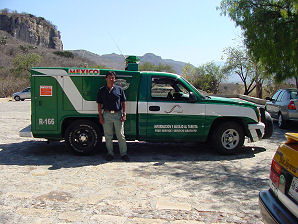
Adan Fernando Castaneda
Our Driver And Guide
In Oaxaca Adan Fernando Castaneda
Standing Next To
Tourist Assistance Truck 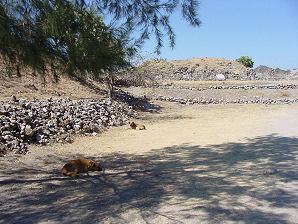
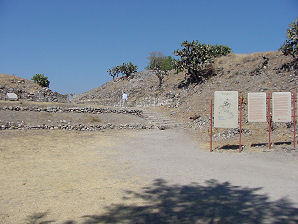
Guard Dogs Yagul Entrance 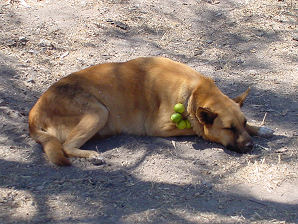
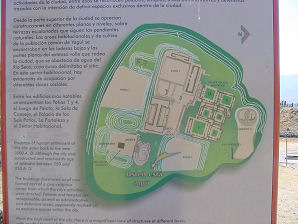
Dog With
Natural Insect Repellant On Site Sign 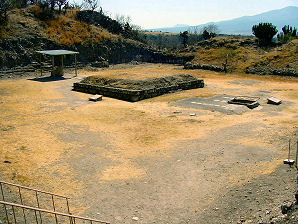
Patio Four
And Triple Tomb
Also Called Frog
Or Sunken Patio
Also Called Eastern Patio Tomb 29 Entrance 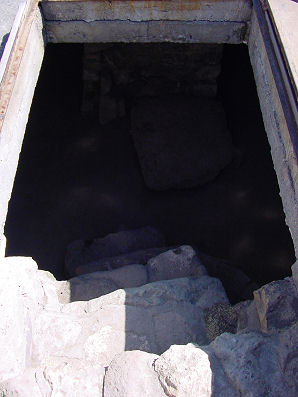
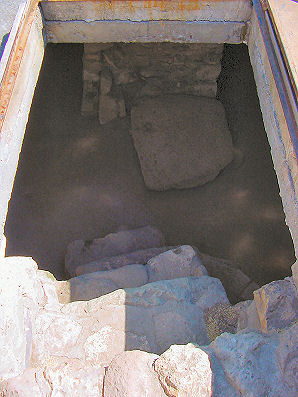
Entering Triple Tomb Entering Triple Tomb 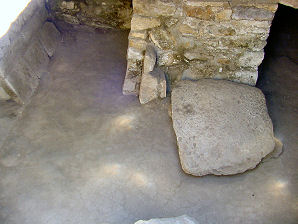

Entering Triple Tomb
Going ESE NNE Tomb (Tomb 30)
Left Of Entrance 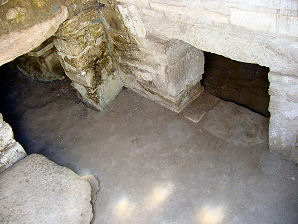

SSW Tomb Right Of
Entrance (Tomb 29)
Left Tomb Is SW
Tomb (Tomb 3) NNE Tomb,
(Tomb 30) Main Tomb 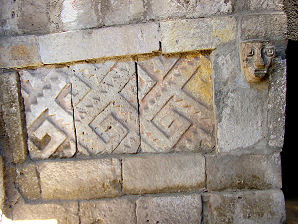

Tomb 30,
Left Door Jamb Tomb 30,
Right Door Jamb 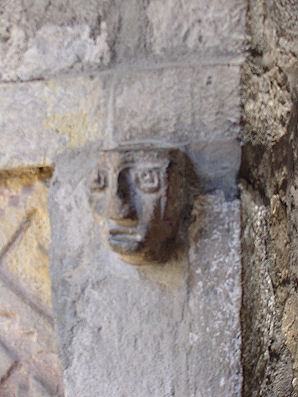
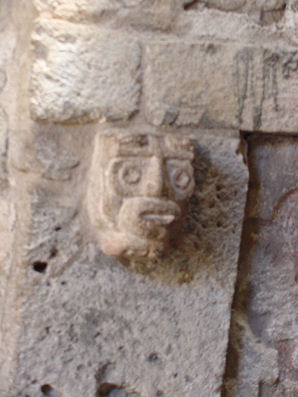
Tomb 30,
Left Door Jamb Tomb 30,
Right Door Jamb 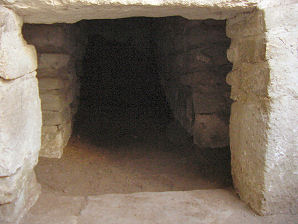
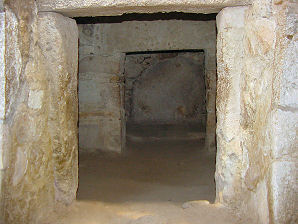
Inside Tomb Three Inside Tomb Twenty Nine 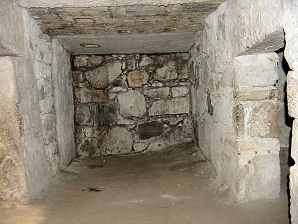
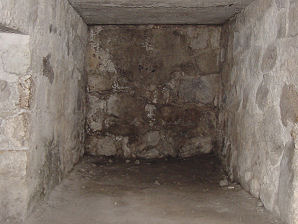
Inside Tomb Thirty Inside Tomb Thirty 
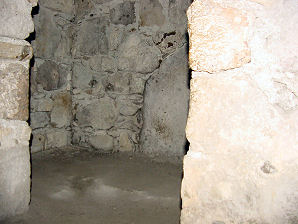
Inside Tomb Thirty Inside Tomb Thirty 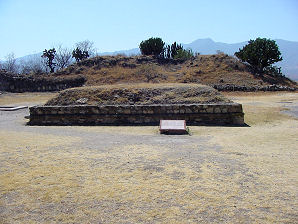
Frog Or Sunken Patio Colosal Monolith
Frog Or Jaguar 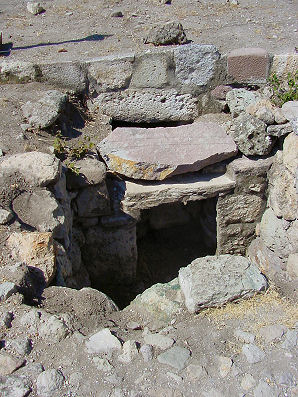

Another Tomb
In Patio Four Another Tomb
In Patio Four
We Are Proud Of Our SafeSurf Rating!
Click On Any Of The Following Links By Amazon.Com
For Books Or Videos About Touring In Mexico. No Obligation!
Click On The Bottom Link Marked GO, Then Look At The Bottom Of The Page That Comes Up.
There You Will See Travel Agencies That Are Recommended By Amazon.Com
For Touring In Mexico. No Obligation!
Here Are Some Links To The Very Best & Most Popular Items Sold On Amazon.Com
To Learn More! Click The Links Below. No Obligation, Of Course!
Other Oaxaca Region Ruins & Attractions!
Yagul: There is plenty to see at Yagul (thought to be contemporary with Mitla) like tombs, the largest ball court found in the Oaxaca Valley, fretted stone mosaics, the ruins on the acropolis, and the huge defensive walls of the fortress at the top of the hill. A good place to see on the way back from Mitla. Yagul is located 20 miles east of Oaxaca city; Yagul is open daily from 10 A.M. to 5 P.M. Evidence suggests that early human settlement at Yagul was as early as 3000 B.C. Although most of Yagel was built and reached its age of splendor between 750 - 950 A. D. Yagul was subsequently abandoned for a short period, but then emerged as a city-state in the Valley of Oaxaca and prevailed until shortly before the arrival of the Spanish Conquistadores. It was settled by Zapotecs, who still populate much of the Tlacolula Valley. This important prehispanic center, whose name literally means "Old Stick" or "Old Tree", contains the largest ballcourt in the Oaxaca Valley, and the second largest in all of Mesoamerica. There are three parts to this fortified site. In the center, staircases lead from an enormous man-made platform to the temples and main palaces. The acropolis containing an atalaya grantica overlooks the site and the rest of the Tlacolula Valley. The view of the Tlacolula Valley from the defensive walls above the site is unequaled. Stairs lead up toward the mountain, where the majority of the town's population lived. A relatively unexplored region on the other side of the river south of Yagul contains a small palace with grecas and other modest residences. The site's architecture is similar in many ways to that of Monte Alban. It's Palace of Six Patios is almost identical to the Group of the Columns at Mitla. This enormous labyrinth-like structure was inhabited by the ruler, or rulers, of Yagul. This has been totally excavated, and surrounding the six patios are rooms with one or three entrances. The walls are made of stone and clay covered with stucco; the floors are made of red stucco. Some rooms were most certainly closed when the building was occupied. There is a throne in the northwestern patio of the southern room. To the west of these patios lie cruciform tombs. Of these, the best known is the Triple Tomb in the patio known as the Frog, or Sunken Patio. The plaza containing the Patio of the Triple Tomb is surroundeed by four temples. In the lower part of the eastern temple is a colosal monolith with an animal figure that may be a frog or a jaguar. An opening leads to the Triple Tomb. The stone facade of the principal tomb is decorated with engravings of two magnificant human heads. The door to the tomb is a slab containing hieroglyphic motifs on both sides. The Triple Tomb was constructed in about 600 B.C. and it continued to be used until about 950 A.D. On a long, narrow street to the south of the Palace of the Six Patios one finds stone mosaics identical to those at Mitla. The stone floor was quarried from the mountain. This streets ends in a long, narrow room known as the Sala de Consejo (Council Chamber) which was previously decorated with stone mosaics that have since disappeared. One enters the room via a staircase which leads to a large patio. To the west, there is a ceremonial building, and to the the east, the ballcourt; the largest ball court in the Oaxaca Valley. Page Two will show images of these areas.
|
Click On Any Of The Following Links By Amazon.Com
For Books Or Videos About Oaxaca Mexico. No Obligation!
The Xoxocotlán International airport (IATA: OAX, ICAO: MMOX) Is the international airport located at Oaxaca, Oaxaca, Mexico. It handles the national and international air traffic for the city of Oaxaca.
We have links on this page that will connect you with flights into and out of the Xoxocotlán International airport and allow you to book any of several of the best hotels in Oaxaca.
We suggest getting a hotel and then letting them arrange either a car or a tour of Oaxaca. If you call their Concierge Services ahead of your arrival, all of this can be pre-arranged for you.
We do this all the time, when traveling in Mexico. It is safe and it works!!! We have never experienced a problem, doing it this way!
We have placed links to Priceline.com on this page so you can arrange your flights into and out of Oaxaca; as well as your hotel, when visiting this area. We found that generally speaking, they provide the best hotel and air flight prices into Oaxaca.

Yagul Map, Photo From Site.


Adan Fernando Castaneda
Our Driver And Guide
In Oaxaca Adan Fernando Castaneda
Standing Next To
Tourist Assistance Truck 

Guard Dogs Yagul Entrance 

Dog With
Natural Insect Repellant On Site Sign 
Patio Four
And Triple Tomb
Also Called Frog
Or Sunken Patio
Also Called Eastern Patio Tomb 29 Entrance 

Entering Triple Tomb Entering Triple Tomb 

Entering Triple Tomb
Going ESE NNE Tomb (Tomb 30)
Left Of Entrance 

SSW Tomb Right Of
Entrance (Tomb 29)
Left Tomb Is SW
Tomb (Tomb 3) NNE Tomb,
(Tomb 30) Main Tomb 

Tomb 30,
Left Door Jamb Tomb 30,
Right Door Jamb 

Tomb 30,
Left Door Jamb Tomb 30,
Right Door Jamb 

Inside Tomb Three Inside Tomb Twenty Nine 

Inside Tomb Thirty Inside Tomb Thirty 

Inside Tomb Thirty Inside Tomb Thirty 
Frog Or Sunken Patio Colosal Monolith
Frog Or Jaguar 

Another Tomb
In Patio Four Another Tomb
In Patio Four
We Are Proud Of Our SafeSurf Rating!
Click On Any Of The Following Links By Amazon.Com
For Books Or Videos About Touring In Mexico. No Obligation!
Click On The Bottom Link Marked GO, Then Look At The Bottom Of The Page That Comes Up.
There You Will See Travel Agencies That Are Recommended By Amazon.Com
For Touring In Mexico. No Obligation!
Here Are Some Links To The Very Best & Most Popular Items Sold On Amazon.Com
To Learn More! Click The Links Below. No Obligation, Of Course!
Other Oaxaca Region Ruins & Attractions!
The Xoxocotlán International airport (IATA: OAX, ICAO: MMOX) Is the international airport located at Oaxaca, Oaxaca, Mexico. It handles the national and international air traffic for the city of Oaxaca. We have links on this page that will connect you with flights into and out of the Xoxocotlán International airport and allow you to book any of several of the best hotels in Oaxaca. We suggest getting a hotel and then letting them arrange either a car or a tour of Oaxaca. If you call their Concierge Services ahead of your arrival, all of this can be pre-arranged for you. We do this all the time, when traveling in Mexico. It is safe and it works!!! We have never experienced a problem, doing it this way! We have placed links to Priceline.com on this page so you can arrange your flights into and out of Oaxaca; as well as your hotel, when visiting this area. We found that generally speaking, they provide the best hotel and air flight prices into Oaxaca.
|
 |
| Yagul Map, Photo From Site. |
|---|
 |  |
| Adan Fernando Castaneda Our Driver And Guide In Oaxaca | Adan Fernando Castaneda Standing Next To Tourist Assistance Truck |
|---|---|
 |  |
| Guard Dogs | Yagul Entrance |
 |  |
| Dog With Natural Insect Repellant | On Site Sign |
 | |
| Patio Four And Triple Tomb Also Called Frog Or Sunken Patio Also Called Eastern Patio | Tomb 29 Entrance |
 |  |
| Entering Triple Tomb | Entering Triple Tomb |
 |  |
| Entering Triple Tomb Going ESE | NNE Tomb (Tomb 30) Left Of Entrance |
 |  |
| SSW Tomb Right Of Entrance (Tomb 29) Left Tomb Is SW Tomb (Tomb 3) | NNE Tomb, (Tomb 30) Main Tomb |
 |  |
| Tomb 30, Left Door Jamb | Tomb 30, Right Door Jamb |
 |  |
| Tomb 30, Left Door Jamb | Tomb 30, Right Door Jamb |
 |  |
| Inside Tomb Three | Inside Tomb Twenty Nine |
 |  |
| Inside Tomb Thirty | Inside Tomb Thirty |
 |  |
| Inside Tomb Thirty | Inside Tomb Thirty |
 | |
| Frog Or Sunken Patio | Colosal Monolith Frog Or Jaguar |
 |  |
| Another Tomb In Patio Four | Another Tomb In Patio Four |
We Are Proud Of Our SafeSurf Rating!
Click On Any Of The Following Links By Amazon.Com
For Books Or Videos About Touring In Mexico. No Obligation!
Click On The Bottom Link Marked GO, Then Look At The Bottom Of The Page That Comes Up.
There You Will See Travel Agencies That Are Recommended By Amazon.Com
For Touring In Mexico. No Obligation!
Here Are Some Links To The Very Best & Most Popular Items Sold On Amazon.Com
To Learn More! Click The Links Below. No Obligation, Of Course!
Other Oaxaca Region Ruins & Attractions!
There You Will See Travel Agencies That Are Recommended By Amazon.Com
For Touring In Mexico. No Obligation!
Here Are Some Links To The Very Best & Most Popular Items Sold On Amazon.Com
To Learn More! Click The Links Below. No Obligation, Of Course!
Other Oaxaca Region Ruins & Attractions!



